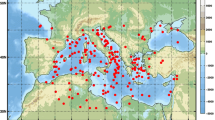Abstract
MONSOON disturbances forming over the north Bay of Bengal and moving towards the WNW across northern India are the main rain producers of the Indian summer monsoon. There are some (monsoon) seasons when these disturbances fail to develop in adequate number and some that do form move towards the northwest or north—these are periods of drought. Understanding how monsoon disturbances develop and why they sometimes do not is an interesting scientific and an important economic problem. Studies so far on monsoon cyclogenesis1,2 have shown that the monsoon atmosphere is not baroclinically unstable. Shukla1 obtained barotropically unstable upper tropospheric modes and emphasised the role of the conditional instability of the second kind (CISK) but failed to get a preferred scale of maximum growth for lower tropospheric disturbances. R.N.K. et al.2 found slowly growing barotropically unstable modes in the lower troposphere corresponding to monsoon disturbances. Mak3 studied the baroclinic instability of monsoon zonal flow with a superposed meridional component, but the meridional winds required for instability were large compared to observed winds. Lorenz4 studied the barotropic instability of Rossby waves and found that shorter waves can be barotropically unstable. V.S. et al.5 showed that the superimposition of a long stationary wave, of the scale of wave number two, on monsoon zonal flow yielded fast growing upper tropospheric modes and lower tropospheric modes of scale 2,500 km, a doubling time of 5 days and slow westwards movement. These correspond well to the observed monsoon disturbances. We report here a combined barotropic–baroclinic stability analysis of monsoon zonal flow with a superimposed long stationary wave (global monsoon) using a two-level quasi-geostrophic model. We show that the phase of the global monsoon wave is a factor in deciding whether a particular year is good for monsoons or for drought.
Similar content being viewed by others
References
Shukla, J. Pap. Int. Symp. Monsoon, New Delhi (1977).
Keshavamurty, R. N., Asnani, G. C., Pillai, P. V. & Das, S. K. Pap. Int. Symp. Monsoon, New Delhi (1977).
Man-kin, Mak. J. atmos. Sci. 32, 2246 (1975).
Lorenz, E. J. atmos. Sci. 29, 258 (1972).
Satyan, V., Keshavamurty, R. N. & Goswami, B. N. Proc. IUTAM/IUGG Symp. on Monsoon Dynamics (ed. Pearce, R. P.) (Cambridge University Press, 1978).
Nitta, T. & Yanai, M. J. meteor. Soc. Japan 46, 389 (1968).
Green, J. S. A. Q.Jl.R. meteor. Soc. 86, 237 (1960).
Krishnamurti, T. N. J. atmos. Sci. 28, 1342 (1971).
Keshavamurty, R. N. Vikram Sarabhai Prize Lecture (1975).
Alexander, G., Keshavamurty, R. N., Mukhopadhyaya, R. K. & Bhonsle, S. G. Nature 253, 463–465 (1974).
Krishnamurti, T. N. Pap. IUTAM/IUGG Symp. on Monsoon Dynamics, New Delhi (1977).
Charney, J. G., Shukla, J. Pap. IUTAM/IUGG Symp. on Monsoon Dynamics, New Delhi (1977).
Author information
Authors and Affiliations
Rights and permissions
About this article
Cite this article
KESHAVAMURTY, R., SATYAN, V. & GOSWAMI, B. Indian summer monsoon cyclogenesis and its variability. Nature 274, 576–578 (1978). https://doi.org/10.1038/274576a0
Received:
Accepted:
Issue Date:
DOI: https://doi.org/10.1038/274576a0
- Springer Nature Limited
This article is cited by
-
Characteristics of the monsoon low pressure systems in the Indian subcontinent and the associated extreme precipitation events
Climate Dynamics (2021)
-
Some aspects of the characteristics of monsoon disturbances using a combined barotropic-baroclinic model
Advances in Atmospheric Sciences (1995)
-
Phase space analysis of Indian summer monsoon rainfall over subdivisions
Journal of Earth System Science (1989)
-
Role of barotropic, baroclinic and combined barotropic-baroclinic instability for the growth of monsoon depressions and mid-tropospheric cyclones
Journal of Earth System Science (1980)
-
Shift of quasi-stationary flow features during active and break monsoons
Journal of Earth System Science (1980)





